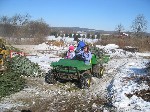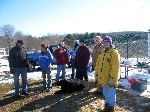Posted on Monday, February 26, 2007
Combine a crisp clear winter day with 111 used Christmas trees, some cut tree branches, an industrial chipper, a warm fire, some snacks, friends of the Field Station of all sorts . . . and you have the proper combination for a productive and fun-filled Saturday.
February 24 dawned clear and cold. Those conditions, plus the challenge of good physical labor, brought out 35 to 40 students, community members, and friends from afar to the Field Station. Huge amounts of energy were spent toting trees and pushing them into the chipper's hopper thus changing recognizable greenery into compostable chips. These alumni and friends of the Field Station were not only local, but came from eastern Ohio, Pittsburgh, Smicksburg and Portland, Ore. The Oregon folks, who live in a state that purports to be green were family here for a visit. And they had the chance to see western Pennsylvania show its green side in our Third Annual Winter Chipping Party.
These 111 trees weighed about one and one-half tons. Additional branches and leaves, by estimate, weighed another ton to give a yield for the day of two and a half tons of organic matter. The cellulose, lignin, resins and sugars, of the wood and leaves provide a good lesson in how nature works.
These farm-raised trees started 8 to10 years ago as small seedlings no more than six inches tall. They captured energy from the sun to carry on the most basic of natural processes, photosynthesis. The soil added the subtle, but crucial nutrients. Water entered the trees' roots. They grew well, but retained only about 10 per cent of the sun's radiant energy. Then the trees were cut, as with almost any farmer's crop, and sold in a market.
By estimate, those 111 trees represented at least $2,775. They were decorated and enjoyed. The ambiance of an evergreen tree in a home at Christmastime is a tradition of value. . . then, within a few weeks, the tree is pitched. But these symbols of Christmas were rescued by caring people who thought enough about their ecological value to bring them and pile them up at the Field Station. When run through the chipper, those molecules of cellulose, lignin, resins and sugars became feedstocks for compost rows that, this spring, will be mixed with autumn leaves, food waste, shredded paper and manure, to become -- before next summer has passed -- about one a half tons of compost. Good soil.
Wood chips alone, when used as yard mulch, have very little nutritional value. The mixed feedstocks, however, are loaded with those nutrients (especially nitrogen) that make plants grow. Just as the soil (in which the Christmas trees grew for a dozen years) had nutrients to offer, so the mixed compost will, with the help of microorganisms, have captured nutrients to return to the soil. That is a basic cycle of nature. Repeatedly telling that story is what the Field Station is all about!
Curiously, the molecules and ions of plant materials can be recycled. Composting enriches and speeds the process. Energy, however, cannot be recycled! We can "hold" energy for a while -- the longer we hold it, the greater the efficiency. But we can never recover / recycle all of the energy that was held in the cellulose, lignin, resins and sugars. What eventually happens to that potential energy? It leaves the planet as heat, gone forever.
Chipping parties, whether in fall or winter, are about recycling materials and renewing friendships, year after year. Homemade chocolate chip cookies, brought to each party by Kati Edmiston, always add the special touch. Next year same time, same place -- chips, and chocolate chips, ahoy!
Clarence Harms, Director
Field Station


